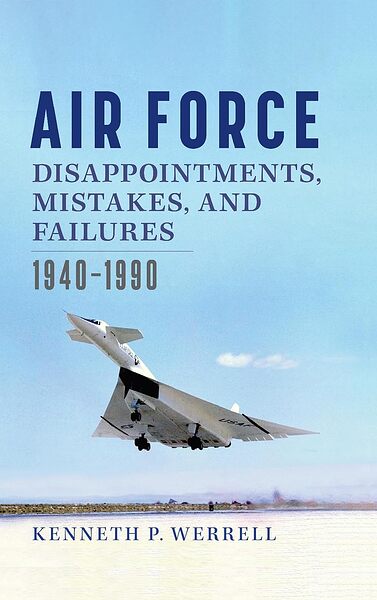Looking for a good read? Here is a recommendation. I have an unusual approach to reviewing books. I review books I feel merit a review. Each review is an opportunity to recommend a book. If I do not think a book is worth reading, I find another book to review. You do not have to agree with everything every author has written (I do not), but the fiction I review is entertaining (and often thought-provoking) and the non-fiction contain ideas worth reading.
Book Review
Sometimes an Eagle Hatches a Turkey
Reviewed by Mark Lardas
April, 21, 2024
“Air Force Disappointments, Mistakes, and Failures: 1940-1990,” by Kenneth P. Werrell, Texas A&M University Press. March, 2024, 312 pages, $55.00 (Hardcover)
Over its existence the US Army Air Force and its successor, the US Air Force produced war-winning and spectacularly successful aircraft. Among them were the P-51, B-29, B-52, C-130, and F-15. Not all their aircraft were eagles. There were turkeys in the mix; even a few goose eggs.
“Air Force Disappointments, Mistakes, and Failures: 1940-1990,” by Kenneth P. Werrell, looks at the flip side of the coin. It examines not-so-great entries to the Air Force inventory. It includes missiles and electronics, too.
Some aircraft included in this collection are those you might expect to see. The YP-75 Eagle, a fighter produced from bits and pieces of other aircraft by automaker General Motors, set a benchmark for awful. So did the parasite fighter XF-85 Goblin. The nuclear-powered NB-36H takes a prize for the “what were they thinking?” award.
Others, like the B-58 Hustler, XB-70 Valkyrie, and Rockwell B-1A were spectacular aviation achievements. They just lacked a meaningful role after newer technology made them impractical. Others were good ideas that did not pan out. These included the XB-40, the escort version of the B-17 or the idea of putting ICBMs on railcars. A few, like the F-104 Starfighter, were downright dangerous, even if commercially successful.
Yet most were not outright failures or mistakes, Werrell shows. They were disappointments. They came in second best to a better aircraft, like the B-32 did to the B-29 or the B-70 did with the B-52. Or they were forced on the Air Force to fit a mission the Air Force did not fill. Navy dive bomber in World War II (the Douglas A-24 and A-25 – aka the Dauntless and Helldiver in the Navy) or the F-111 were examples. In World War II ground support was better done by fighter-bombers and the F-111 simply attempted too much by being all things to all services.
Werrell provides 26 case studies involving nearly fifty different aircraft, missiles, and weapons systems that failed to deliver the goods for the Air Force. Each one goes into the thinking that started each project. He then traces what went wrong and why. He shows the importance of function. If the aircraft fills an unneeded function or cannot fill it better than other candidates, disappointment follows.
“Air Force Disappointments, Mistakes, and Failures” is a fascinating book. While mainly of interest to those fascinated by aircraft, it is a marvelous examination of the engineering process.
Mark Lardas, an engineer, freelance writer, historian, and model-maker, lives in League City. His website is marklardas.com.
